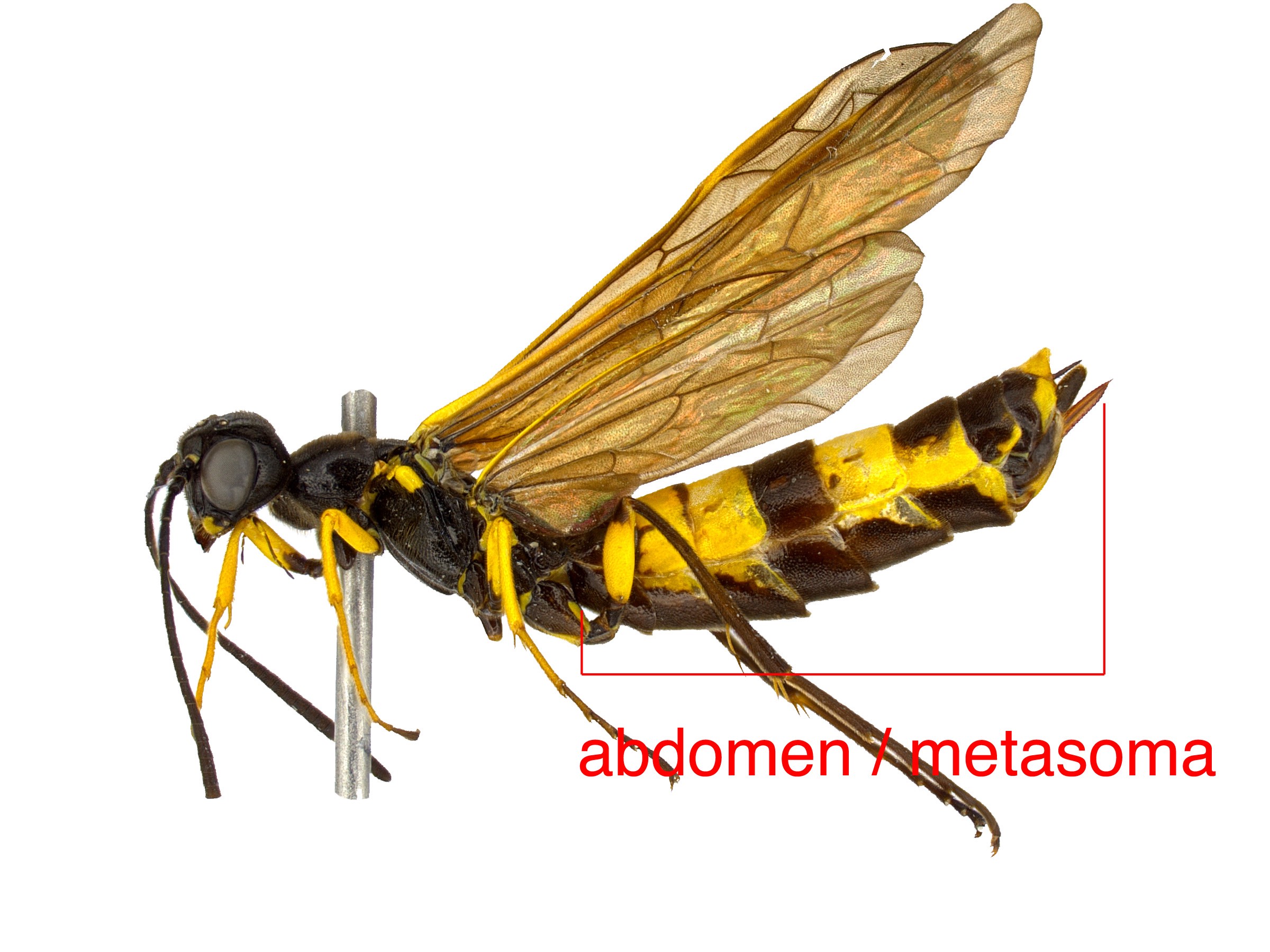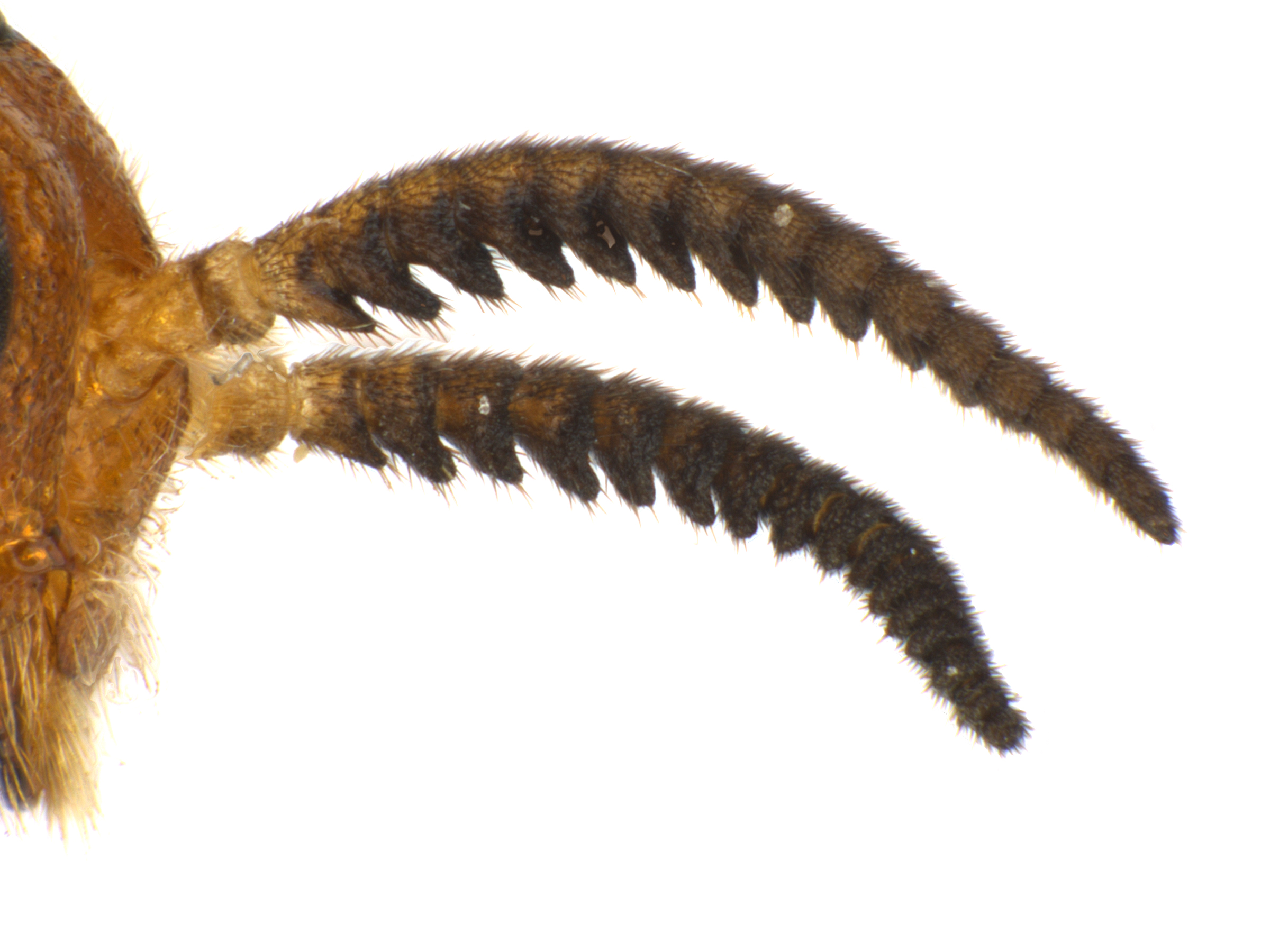Family: Diprionidae
Family common name: coniferconifer:
a usually evergreen tree characterized by reproductive cones; e.g., pine, fir, spruce, larch, etc.
sawflies
Subfamily: Monocteninae
Genus: Augomonoctenus Rohwer, 1918
Subgenera: none
The Diprionidae are known as the coniferconifer:
a usually evergreen tree characterized by reproductive cones; e.g., pine, fir, spruce, larch, etc.
sawflies, though they are not the only family to use coniferconifer:
a usually evergreen tree characterized by reproductive cones; e.g., pine, fir, spruce, larch, etc.
trees as hosts (others include Siricidae, Pamphiliidae, Xyelidae, and some Tenthredinidae). Many are destructive pests as larvaelarva:
the immature stage of holometabolous insects
 , and their biology has been relatively well-studied. Diprionids have stout bodies and distinctive antennal characteristics that make adults easy to recognize (Furniss and Carolin 1977Furniss and Carolin 1977:
, and their biology has been relatively well-studied. Diprionids have stout bodies and distinctive antennal characteristics that make adults easy to recognize (Furniss and Carolin 1977Furniss and Carolin 1977:
Furniss RL and Carolin VM. 1977. Western forest insects. United States Deptartment of Agriculture Forest Service Miscellaneous Publication 1339: 1-655.).
Augomonoctenus feeds on the cones of their coniferconifer:
a usually evergreen tree characterized by reproductive cones; e.g., pine, fir, spruce, larch, etc.
host. Adults of the most common species, A. libocedrii, are small, about 5–9 mm long, robust, and metallic blue-black with a bright red abdomenabdomen:
the third and last segment of an insect's body; in sawflies this is usually made up of 11 segments (segments 9 and 10 often fused) . They have a small range on the Pacific coast and are seldom collected (Rohwer 1918Rohwer 1918:
. They have a small range on the Pacific coast and are seldom collected (Rohwer 1918Rohwer 1918:
Rohwer SA. 1918. New sawflies of the subfamily Diprioninae (Hym.). Proceedings of the Entomological Society of Washington 20 (4): 79-90., Keen 1958Keen 1958:
Keen FP. 1958. Cone and seed insects of western forest trees. USDA Technical Bulletin 1169., Smith 1993Smith 1993:
Smith DR. 1993. Systematics, life history, and distribution of sawflies. Pp. 3-32. In: Wagner MR and Raffa KF, eds. Sawfly Life History Adaptations to Woody Plants. University of Minnesota Academic Press. 581 pp.).
There are three described species worldwide, two of which occur in North America (Taeger et al. 2010Taeger et al. 2010:
Taeger A, Blank SM, and Liston AD. 2010. World Catalog of Symphyta (Hymenoptera). Zootaxa 2580: 1-1064.).
 strongly constricted medially, as seen from above (Goulet 1992Goulet 1992:
strongly constricted medially, as seen from above (Goulet 1992Goulet 1992: , no distinct “neck” (Goulet 1992Goulet 1992:
, no distinct “neck” (Goulet 1992Goulet 1992: in females, unipectinateunipectinate:
in females, unipectinateunipectinate: in males (Smith 1974, Goulet 1992Goulet 1992:
in males (Smith 1974, Goulet 1992Goulet 1992: 1A and 2A of fore wingfore wing:
1A and 2A of fore wingfore wing: fused in the center, making two distinct anal cells without a crossveincrossvein:
fused in the center, making two distinct anal cells without a crossveincrossvein: slightly emarginateemarginate:
slightly emarginateemarginate: vein M meeting Rs+M before merging with Sc+R (Smith 1974bSmith 1974b:
vein M meeting Rs+M before merging with Sc+R (Smith 1974bSmith 1974b: flat (Smith 1974bSmith 1974b:
flat (Smith 1974bSmith 1974b:Diprionidae are easily recognized by the distinctive antennaeantenna:
the sensory organ emerging from the front of the head, usually between the compound eyes and above the clypeus; includes the flagellum, scape and pedicel
 of both sexes and their small, stout bodies. The subfamily Monocteninae can be separated from Diprioninae (Diprion, Gilpinia, Neodiprion, Zadiprion) by the singular comb-like projection from each antennal segment, and by the veins 1A and 2A fused in the fore wingfore wing:
of both sexes and their small, stout bodies. The subfamily Monocteninae can be separated from Diprioninae (Diprion, Gilpinia, Neodiprion, Zadiprion) by the singular comb-like projection from each antennal segment, and by the veins 1A and 2A fused in the fore wingfore wing:
the anterior wing of each pair of wings; usually the largest wing of the pair
 . It can be separated from Monoctenus by the emarginated clypeusclypeus:
. It can be separated from Monoctenus by the emarginated clypeusclypeus:
sclerotized area on the front of the head located between the antennal insertions and labrum
 and the flat face (Smith 1974bSmith 1974b:
and the flat face (Smith 1974bSmith 1974b:
Smith DR. 1974b. Conifer sawflies, Diprionidae: Key to North American genera, checklist of world species, and a new species from Mexico (Hymenoptera). Proceedings of the Entomological Society of Washington 76: 409-418., Goulet 1992Goulet 1992:
Goulet H. 1992. The genera and subgenera of the sawflies of Canada and Alaska: Hymenoptera. Symphyta. The insects and arachnids of Canada. Part 20. Agriculture Canada Publication.).
The host of Chinese species A. smithi is Cupressus funebris (Chinese weeping cypress), which does not commonly occur in North America (Wei et al. 2006Wei et al. 2006:
Wei M, Nie H, and Taeger A. 2006. Sawflies (Hymenoptera: Symphyta) of Chinamdash;checklist and review of research. Pp. 505-574. In: Blank SM, Schmidt S, and Taeger A, eds. Recent sawfly research mdash; synthesis and prospects. Goecke amp; Evers, Keltern., USDA NRCS Plants Database 2019USDA NRCS Plants Database 2019:
USDA Natural Resources Conservation Service PLANTS Database. Accessed January 2019. https://plants.usda.gov).
Larvae in North America of A. libocedrii feed on cones of Calocedrus decurrens (incense cedar) (Rohwer 1918Rohwer 1918:
Rohwer SA. 1918. New sawflies of the subfamily Diprioninae (Hym.). Proceedings of the Entomological Society of Washington 20 (4): 79-90.). The host of A. pilosus is unknown (Middlekauff 1967Middlekauff 1967:
Middlekauff WW. 1967. A new species of Augomonoctenus from California. The Pan-Pacific Entomologist 43 (4): 272-273.).
Natural history details for this genus are only known for A. libocedrii, which feeds as a larvalarva:
the immature stage of holometabolous insects
 on the incense cedar cones (Keen 1958Keen 1958:
on the incense cedar cones (Keen 1958Keen 1958:
Keen FP. 1958. Cone and seed insects of western forest trees. USDA Technical Bulletin 1169.). The mature larvaelarva:
the immature stage of holometabolous insects
 burrow into the soil and remain in diapausediapause:
burrow into the soil and remain in diapausediapause:
a non-active period of no development; sawflies often enter diapause as a prepupa or pupa to overwinter
until pupation and subsequent emergence, which is recorded to occur every two years (Middlekauff 1967Middlekauff 1967:
Middlekauff WW. 1967. A new species of Augomonoctenus from California. The Pan-Pacific Entomologist 43 (4): 272-273.). This species does not cause significant damage to the host (Furniss and Carolin 1977Furniss and Carolin 1977:
Furniss RL and Carolin VM. 1977. Western forest insects. United States Deptartment of Agriculture Forest Service Miscellaneous Publication 1339: 1-655.).
World: Two species occur in North America, and one, A. smithi, is known from the Sichuan province of China (Wei et al. 2006Wei et al. 2006:
Wei M, Nie H, and Taeger A. 2006. Sawflies (Hymenoptera: Symphyta) of Chinamdash;checklist and review of research. Pp. 505-574. In: Blank SM, Schmidt S, and Taeger A, eds. Recent sawfly research mdash; synthesis and prospects. Goecke amp; Evers, Keltern.).
North America: Both North American species are western. Augomonoctenus pilosus is known from southern California (Middlekauff 1967Middlekauff 1967:
Middlekauff WW. 1967. A new species of Augomonoctenus from California. The Pan-Pacific Entomologist 43 (4): 272-273.). Augomonoctenus libocedrii has a broader recorded range and occurs in Oregon and northern California (Rohwer 1918Rohwer 1918:
Rohwer SA. 1918. New sawflies of the subfamily Diprioninae (Hym.). Proceedings of the Entomological Society of Washington 20 (4): 79-90., Smith 1974bSmith 1974b:
Smith DR. 1974b. Conifer sawflies, Diprionidae: Key to North American genera, checklist of world species, and a new species from Mexico (Hymenoptera). Proceedings of the Entomological Society of Washington 76: 409-418.).
Map data from: GBIF.org (26 June 2019) GBIF Occurrence Download Augomonoctenus
Details about data used for maps can be found here.